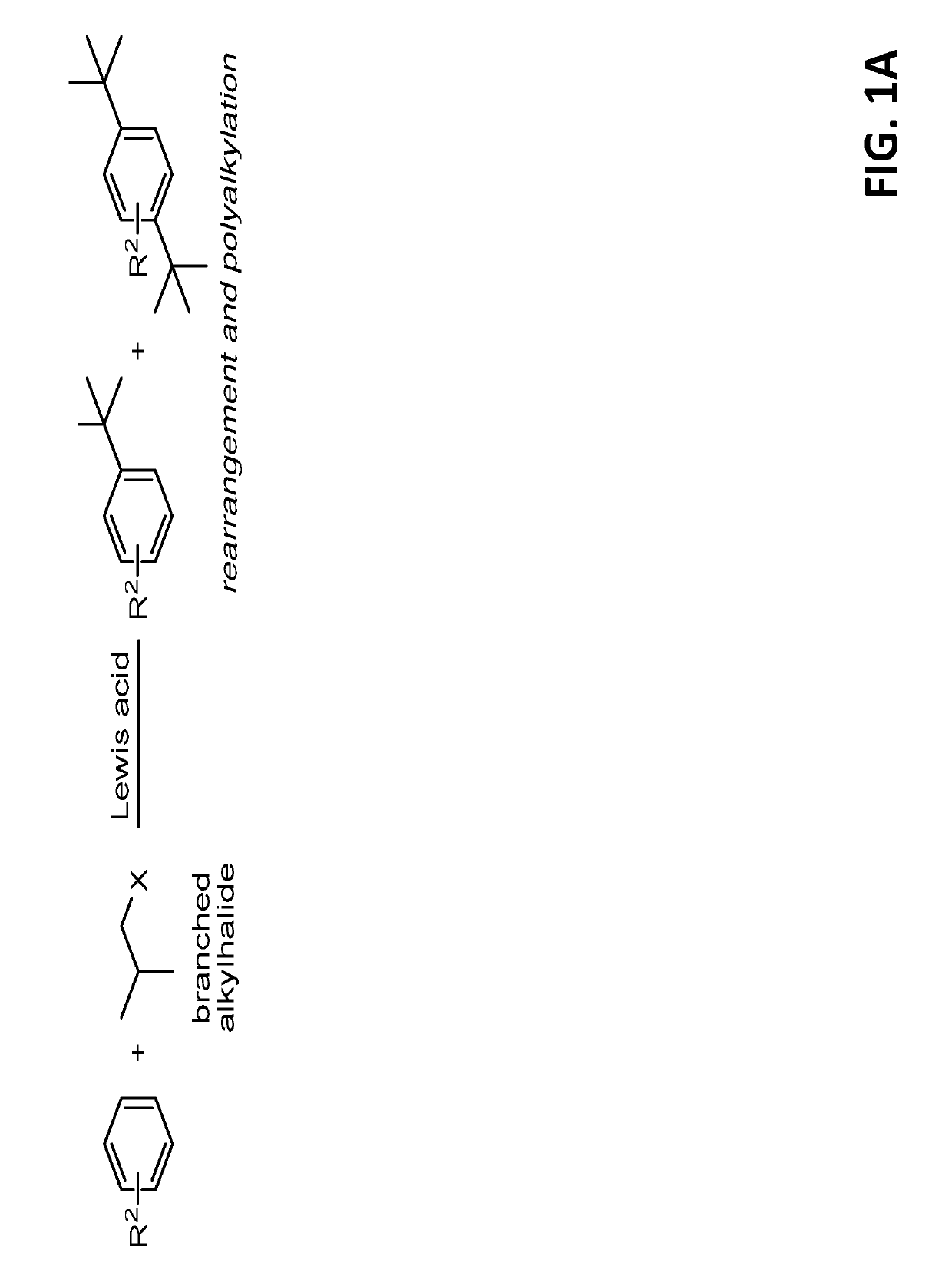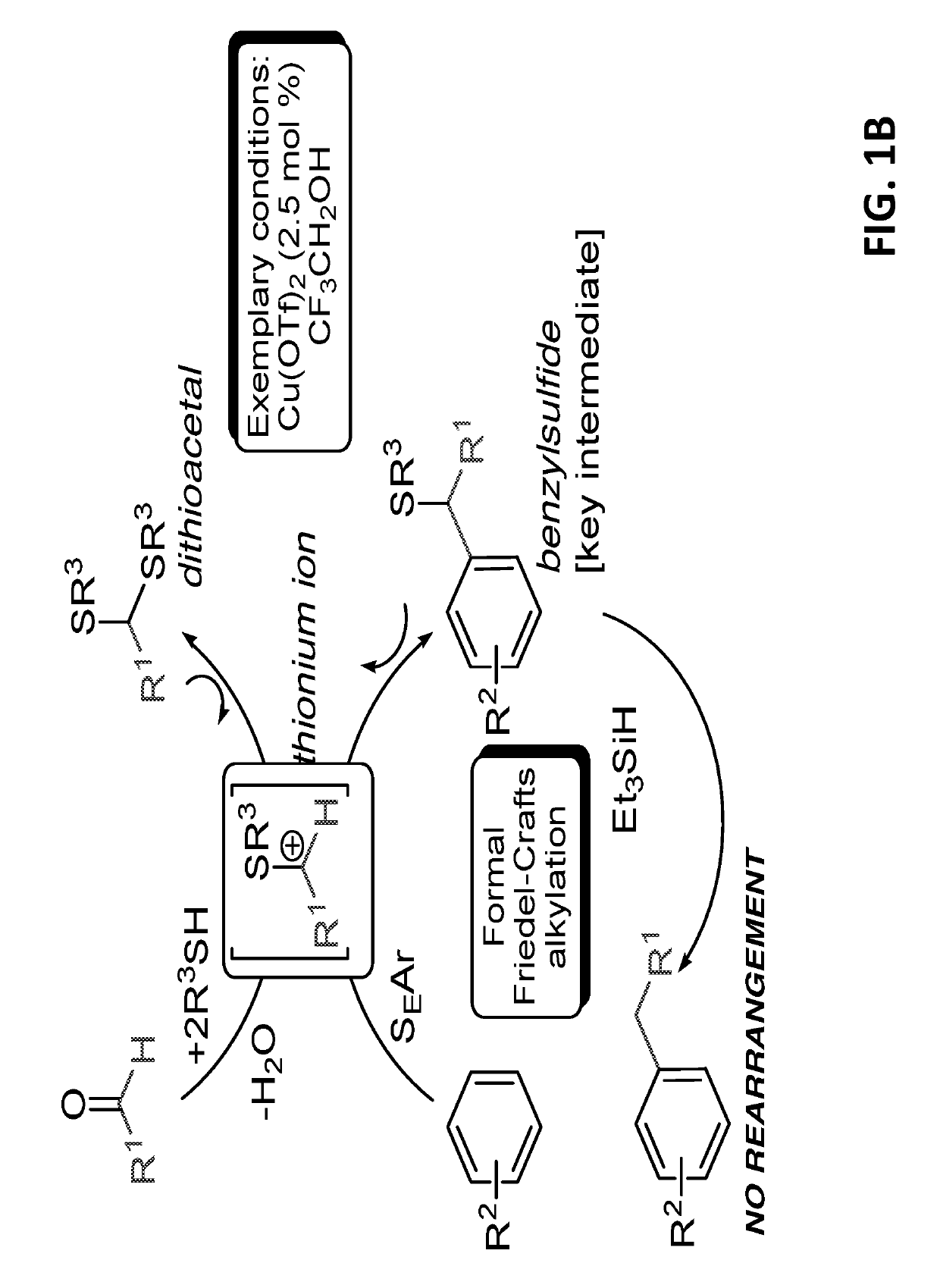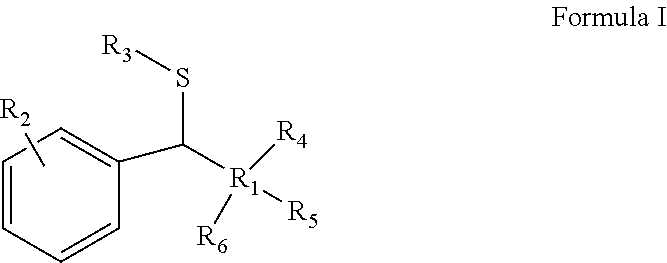Introduction of alkyl substituents to aromatic compounds
a technology of alkyl substituents and aromatic compounds, applied in the direction of mercapto/sulfide group formation/introduction, heterocyclic compound active ingredients, organic reduction, etc., can solve the problems of affecting the applicability of the process and unsuitable for primary alkyl halides
- Summary
- Abstract
- Description
- Claims
- Application Information
AI Technical Summary
Benefits of technology
Problems solved by technology
Method used
Image
Examples
example 1
Process A: Reaction of Aldehyde, Arene and Thiol
[0359]
[0360]In exemplary procedures, the benzylation of electron rich arenes with benzaldehydes of different electronic natures can be carried out in the presence of different thiols.
[0361]Electron deficient aldehydes are more reactive than electron rich aldehydes, while the reaction of benzaldehyde with 2,6-dimethylphenol using thioacetic acid as the promoter reached completion within minutes at room temperature affording obtaining product A1 in 98% yields.
[0362]
[0363]Polar functional groups, such as, —OH, —OMe, —CO2H, —CN, —SMe, —Br and —NMe2 are robust under the reaction conditions. The reaction is highly efficient for both linear and branched aliphatic aldehydes, affording benzylsulfides such as A2:
[0364]
[0365]in moderate to high yields (up to 92% yield).
[0366]Surprisingly, under the reaction conditions, side processes, such as polyalkylation of the aromatic ring or nucleophilic substitution of the benzylsulfide group were not obse...
example 2
Process B; Reduction of the Thiol
[0471]An exemplary embodiment of the process of the invention is shown in the following equation:
[0472]
[0473]In Process B (also referred to as: “Method B”) the products obtained according by process A were reduced by Et3SiH as described hereinbelow, to thereby form a compound represented by Formula IV, as defined hereinabove.
[0474]Synthesis of Specific Compounds:
[0475]In exemplary procedures, “process A” was first performed, i.e. a solution of aldehyde (0.75 mmol), arene (0.25 mmol), ethanethiol (1.5 mmol) and Cu(OTf)2 (2.5 mol %) in 2,2,2-trifluoroethanol (0.75 mL), (1.5 mmol) was stirred at the required temperature.
[0476]Upon completion, the reaction mixture was cooled to room temperature and triethylsilane (0.75 mmol) was added and the reaction was stirred at 50° C. At the end of the reduction process, all volatiles were removed under reduced pressure and the crude residue purified over silica-gel chromatography affording the desired coupling prod...
example 3
Exploring the Role of the Thiol in the Synthesis Route
[0548]General:
[0549]Scheme 2 presents exemplary electrophilic aromatic substitution of aldehydes and thionium ions following mixing 2-naphthol (1a in scheme 2) with an excess of isobutyraldehyde (2a in scheme 2) under acid-catalyzed conditions (Cu(OTf)2 (5 mol %), 2,2,2-trifluoroethanol, room temperature) produced a complex reaction mixture, with naphthofurans being the major products (28% and 14% yields, respectively):
[0550]
[0551]In exemplary procedure, a solution of isobutylaldehyde (68 μl, 0.75 mmol) was treated with Cu(OTf)2 (2.2 mg, 2.5 mol %) at rt in trifuloroethanol (0.75 ml), followed by addition of 2-naphthol (36 mg, 0.25 mmol). The mixture was stirred for 10 h at 60° C. The residual material was purified by column chromatography (silica gel 40-60, hexane / ether 98:2) to obtain compound 3 in scheme 2 (also referred to as “RP_984”) (13.7 mg, 28% yield) as white solid.
Compound A1′ and A2′:
[0552]Characterization data of com...
PUM
| Property | Measurement | Unit |
|---|---|---|
| temperature | aaaaa | aaaaa |
| temperature | aaaaa | aaaaa |
| temperature | aaaaa | aaaaa |
Abstract
Description
Claims
Application Information
 Login to View More
Login to View More - R&D
- Intellectual Property
- Life Sciences
- Materials
- Tech Scout
- Unparalleled Data Quality
- Higher Quality Content
- 60% Fewer Hallucinations
Browse by: Latest US Patents, China's latest patents, Technical Efficacy Thesaurus, Application Domain, Technology Topic, Popular Technical Reports.
© 2025 PatSnap. All rights reserved.Legal|Privacy policy|Modern Slavery Act Transparency Statement|Sitemap|About US| Contact US: help@patsnap.com



